ANCIENT MESOPOTAMIA
Portrait of a Dead Civilization
by A. Leo Oppenheim
Revised Edition
Completed by Erica Reiner
THE UNIVERSITY OF CHICAGO PRESS
Chicago & London
THE UNIVERSITY OF CHICAGO PRESS, CHICAGO 60637
The University of Chicago Press, Ltd., London
1964, 1977 by The University of Chicago
All rights reserved. Published 1977
Printed in the United States of America
15 14 13 12 11 10 09 12 13 14 15
ISBN: 978-0-226-17767-0 (ebook)
ISBN-13: 978-0-226-63187-5 (paper)
ISBN-10: 0-226-63187-7 (paper)
Library of Congress Cataloging-in-Publication Data
Oppenheim, A. Leo, 19041974.
Ancient Mesopotamia : portrait of a dead civilization.
Includes bibliographical references and index.
1. Civilization, Assyro-Babylonian. 2. IraqCivilizationTo 634. I. Reiner, Erica, 1926 II. Title.
DS69.5.06 1976 935 76-28340
 The paper used in this publication meets the minimum requirements of the American National Standard for Information SciencesPermanence of Paper for Printed Library Materials, ANSI Z39.48-1992.
The paper used in this publication meets the minimum requirements of the American National Standard for Information SciencesPermanence of Paper for Printed Library Materials, ANSI Z39.48-1992.
TO OTTO NEUGEBAUER IN ADMIRATION
Illustrations
PLATES
MAPS
Acknowledgments
This book could hardly have been written anywhere but in the stimulating atmosphere of the Assyrian Dictionary Project of the Oriental Institute of the University of Chicago. In that constant give and take of ideas and information, in that sustained drive for the understanding of the entire gamut of the Mesopotamian text material which determines our work, I have formed my viewspreferences and idiosyncrasies alike. To the scholars, old and young, past and present, who have honored me by working with me on that project, I owe a deeply felt debt of gratitude.
I acknowledge with thanks the permission granted me by Current Anthropology to reprint in the chapter AssyriologyWhy and How, the original version of the article which appeared in Vol. I, Nos. 56 (SeptemberNovember 1960).
I would like to thank my colleague, Erica Reiner, for her careful reading of the manuscript of this book. The appendix, entitled Mesopotamian Chronology of the Historical Period, was written by Dr. J. A. Brinkman, who also was kind enough to read the proofs of the book.
I am grateful to the Division of the Humanities of the University of Chicago for its contribution for secretarial expenses.
I wish to thank Paul Hamlyn, Ltd., for permission to include a number of plates from R. D. Barnetts Assyrian Palace Reliefs. The British Museum Photographic Service has given me permission to include plates from Assyrian Sculptures in the British Museum (1914), by E. A. Wallis Budge; Assyrian Sculptures in the British Museum (1938), by Sidney Smith; and The Sculptures of Assur-Nasir-Apli II, Tiglat-Pileser III, Esarhaddon... (1962), by R. D. Barnett and M. Falkner.
A. LEO OPPENHEIM
Preface to the Revised Edition
Since its first publication in 1964, Ancient Mesopotamia has remained the most distinguished presentation of the civilization of Babylonia and Assyria. The uniqueness and personal quality of the point of view presented in this cultural history have been amply emphasized in the reviews, and the books impact can be measured by the literature stimulated by its first appearance. It is addressed to the educated layman, but it is also an indispensable tool for intellectuals and scholars interested in ancient civilizations. It is a textbook used in colleges and universities in the field of ancient history, and it is also a constant companion of the professional Assyriologist, who turns to it again and again to consider its insights and to find references in the extensive notes and bibliography. This latter function seemed so essential to the author that he had been keeping the critical apparatus current. When asked to prepare a revised edition, he welcomed the opportunity to bring the book up to date with material he had collected for ten years, and to revise some of the statements he had made.
It was characteristic of Leo Oppenheim constantly to reshape his view of Mesopotamian civilization; every new bit of information helped modify his perception of the essence of this civilization. He insisted that his subject was a dead civilization because, as R. M. Adams suggests, for him, the death of his subject matter was somehow a precondition for its productive study, which then had to involve its painstaking, conscious recreation as a formed thing of the mind. All of Oppenheims work was determined by his quest for what makes Mesopotamian civilization, the total understanding of which, he said, would always elude him, an observer from another civilization.
He pursued this elusive understanding through extracting all possible information from the ancient texts and organizing it into entries for the Assyrian Dictionary, a dictionary conceived by a previous generation of scholars as a thesaurus and which became under Leo Oppenheim an encyclopedia of Mesopotamian culture. Oppenheim also believed it his duty to attempt new formulations of his overall view of Mesopotamia. Ancient Mesopotamia is one such formulation, a picture intensely and intentionally personal, which is why, in the subtitle, he called the book a portrait. This being just one possible portrait, a few years later he sketched another, The Measure of Mesopotamia, which appeared as the Introduction to his Letters from Mesopotamia.
Both these presentations show Oppenheims preoccupation with and emphasis on what he called central concerns. Though famous as a philologistone of the foremost Assyriologists and the editor of the Chicago Assyrian DictionaryOppenheim preferred to call himself a cultural anthropologist who happens to work with a civilization whose records are in a dead language and a strange script, full of difficulties which too often claim the scholars total attention. His aim was to make Mesopotamian records as commonly understood as classical ones, which when quoted can stay in the original Latin or Greek. For Oppenheim, texts were only a means to understand cultural history, and he thus greatly helped to establish Assyriology as a discipline of the cultural sciences. Contemporary approaches to the classical world influenced his thinking in many other ways too, as did the contributions of anthropologists from Lovejoy and Boas to Claude Lvi-Strauss.
Oppenheim was concerned with social and economic history from the time of his dissertation, on legal texts concerning rental agreements, to his last project, on the money economy of the temple in the Neo-Babylonian period. He often drew wide implications about bureaucratic or fiscal practices from a single term or an isolated document, yet he warned against simplification in polemical articles, whether directed at the economic theories of Karl Polnyi, with whom Oppenheim collaborated for many years, or at the historical materialism of Soviet scholars.
Oppenheim also had a long-standing commitment to science and technology; he studied the material culture of the Neo-Babylonian period and published the monograph On Beer and Brewing Techniques. He then became increasingly fascinated with the aspirations and achievements of Mesopotamian technology and the Western and Eastern influences that shaped it, as is evidenced in his book Glass and Glassmaking in Ancient Mesopotamia (1970) and in his essay for the Dictionary of Scientific Biography, Man and Nature.
Those who have been offended by the subtitle in of Ancient Mesopotamia, Why a Mesopotamian Religion Should Not Be Written, would do well to consult Oppenheims articles on Mesopotamian Mythology or on the numinous and the terms used to express it, and to follow the model of his Analysis of an Assyrian Ritual (1966) which illustrates the approach to Mesopotamian religion that Oppenheim regarded as more fruitful than lists of gods or festivals.
Next page
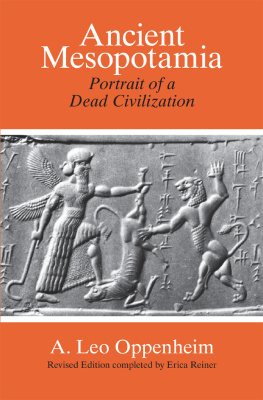

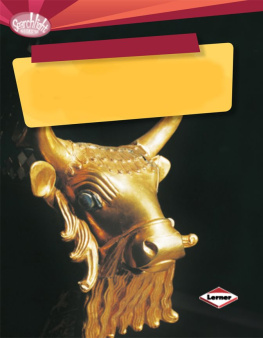
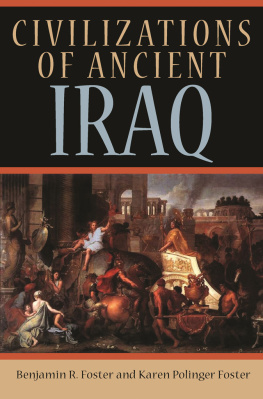

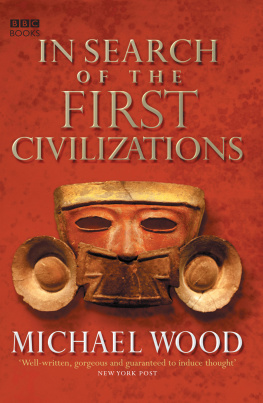
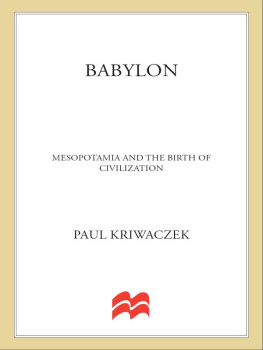
 The paper used in this publication meets the minimum requirements of the American National Standard for Information SciencesPermanence of Paper for Printed Library Materials, ANSI Z39.48-1992.
The paper used in this publication meets the minimum requirements of the American National Standard for Information SciencesPermanence of Paper for Printed Library Materials, ANSI Z39.48-1992.